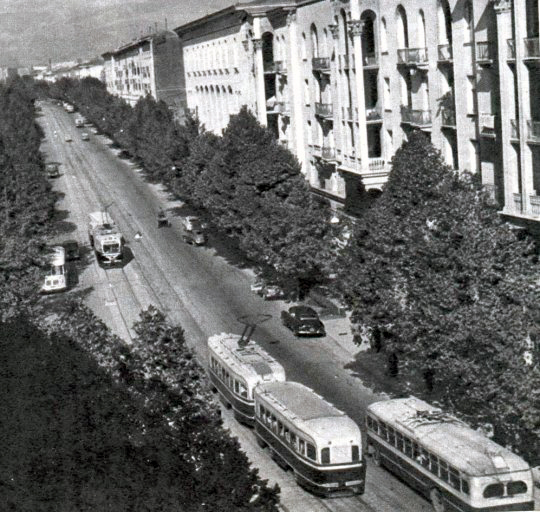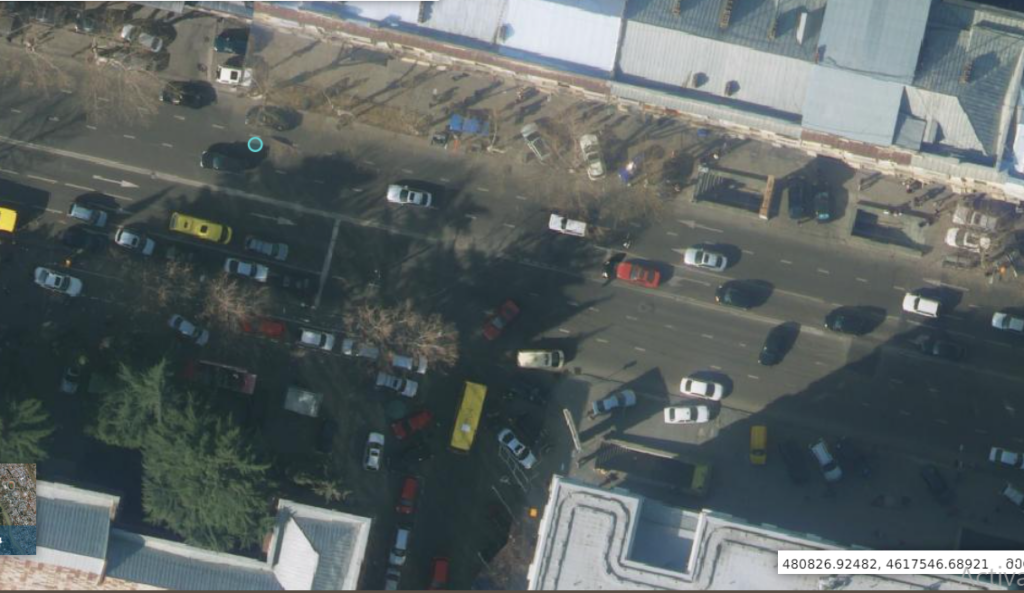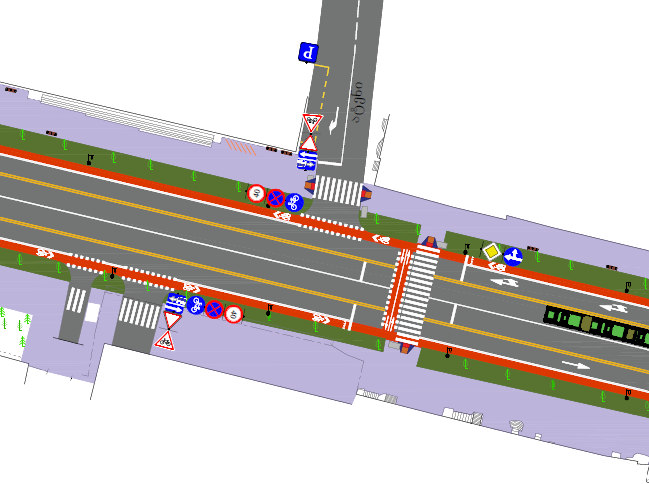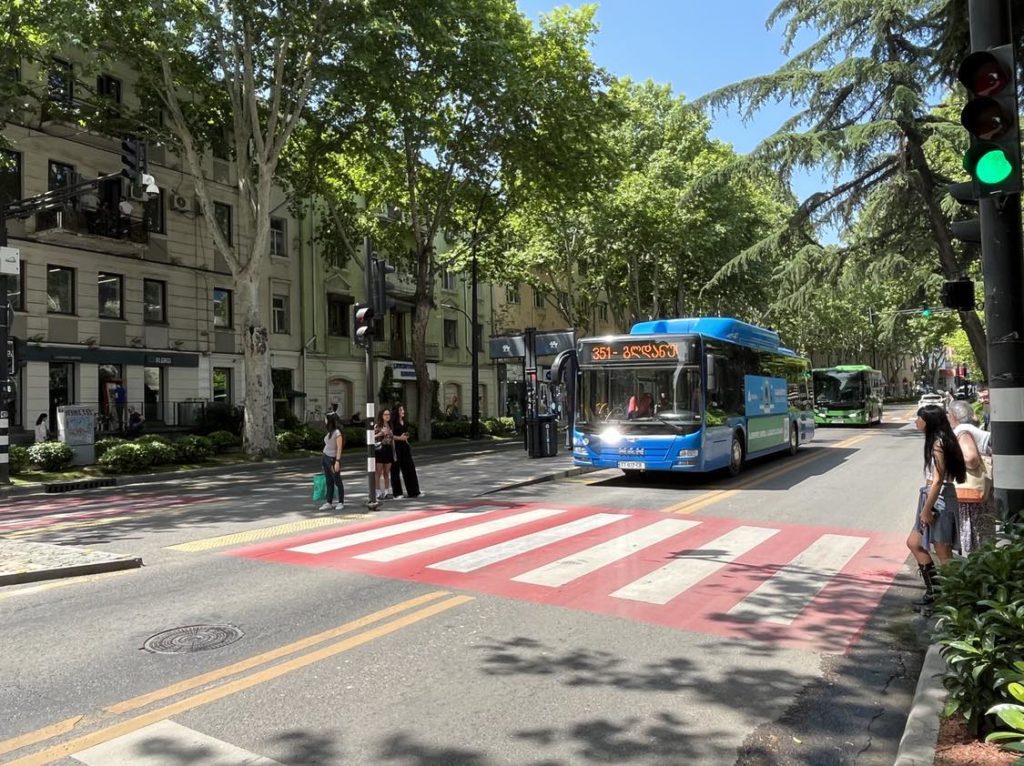The rehabilitation and fundamental transformation of one of Tbilisi’s main thoroughfares – the Chavchavadze Avenue – sparked debates and conflicts over the city’s new transport policy. Many protested that only one car lane was left and car-parking space was reduced in favor of giving space to public transport, cycling and pedestrian infrastructures. Some found the counter-flow organization of bus lanes dangerous and problematic. Yet, others embraced the reform as a key step towards more socio-spatially just urban and mobility planning. In what follows, I retell the history of the transformation of the avenue. I illustrate how precarious and institutionally challenging the accomplishment of such a street redesign can be. I also suggest that the story of redesigning Chavchavadze Avenue shows that even under unfair political rule and precarious institutional settings impressive urban changes are possible.
Transformation of Chavchavadze Avenue from transit oriented to car dominated space
Chavchavadze Avenue is the main avenue in the Vake district, one of Tbilisi’s high-end neighborhoods. This vibrant avenue hosts various university buildings, schools, offices, hotels, banks, cafés and libraries. Throughout its history, the Chavchavadze Avenue went from human centered to car centered design and back. In the first half of the 20th century, it was served with a tramway, later substituted by trolleybuses and articulated buses. In the 1990s, as the public transport system collapsed, urban dwellers managed to get to places using small private busses, the so-called marshrutkas, and informal ride-along practices.

Relative stability and economic development since the early to mid-2000s resulted in rising motorization rates, especially sharply in better-off neighborhoods like Vake. Currently Vake is leading in terms of the share of car-owning households, as well as looking at the numbers of households having access to more than one[1]. A lack of a formally spelled out transport policy until the mid-2010s contributed to extensive car domination in Vake, similarly to and even more radically than in other neighborhoods. Implicitly, existing transport and mobility policies allowed and supported car domination, and an increasing number of public spaces were claimed by cars. Legal and illegal parking on sidewalks, street level crossing substituted by under- and over-passes, high speeds, noise pollution and traffic accidents became a norm.
Start of Tbilisi Mobility Reform
I started working in Tbilisi City Hall (TCH) Transport Department (TD) in 2015[2]. My job was to communicate with international consultancies and donors conducting different transport-related studies. A plethora of fragmented and sometimes even overlapping studies were done without any clear policy or commitment from the government. In most cases, I was usually the only person dealing with the consultancies. International experts were coming and going, studies were conducted, money was spent. Yet the only valuable outcome was that I was getting familiar with the world and language of a donor-driven planning system. This experience definitely helped me later to navigate the uneven grounds of communication between the Tbilisi City Hall (TCH) and consultancies when working on the Tbilisi mobility reform.

By the end of 2017, under the leadership of a new mayor, Kakhi Kaladze, the City Hall embarked on the sustainable mobility reform. The reform was overdue and well justified in the light of severe mobility challenges, leading to rampant socio-spatial injustices in the city. 2016 Tbilisi mobility household data clearly indicated inequalities in terms of access to transport and access to opportunities for different groups based on income, gender, age and center vs periphery. At that time 58% of households did not own a single car. According to the survey, car ownership is clearly linked to increasing income[3]. Central neighborhoods are more motorized than peripheral ones, while those central areas also have better public transport, better pedestrian infrastructure, and diversity of functions. In contrast, peripheral neighborhoods have worse public transport coverage and are characterized by lack of many important uses and functions, such as jobs, education, recreation, healthcare and social-cultural uses. Women have less access to cars, only 10% of daily trips are by car, while for men this number is 45%[4]. Elderly and children’s main mode is walking, while students are mostly using public transport3. This way, the car dominated mobility system had an evident privileged group – mostly high income males — while for the rest of the citizens moving around the city is associated with not only struggle and double or triple travel times, but also risk of life.
As the urban mobility reform was announced, I was already planning to leave my job at the TCH, but changed my mind as I wanted to see where the new mayors’ commitment would take us. Although official statements promised to develop public transport and alternatives to car, it was not clear even inside TCH what this reform would entail. The level of understanding what sustainable mobility represents, and what had to be done, varied among officials at different hierarchy levels and across departments. Even the employees of the Transport Department were not too much interested in the new policy. Few of us were hoping for this political change for a long time, and largely had two main questions: what if it is just another false promise? If not, how could we, with our very small technical capacity support the reform? Fortunately, some grant-financed studies and technical assistance were on the way. In 2018, TCH signed a contract with a French consultancy company, Systra, to study and plan a new bus network. In parallel, a team of British experts were working in TD as integrated experts promoting the need for bus priorities, while also supporting us in capacity building. A planning team was created in TD for the first time. The new policy required change not only in ways city was planned, but also in ways the institutional processes worked.
The bumpy road towards new mobility priorities
The redesign of the Chavchavadze Avenue towards more equitable distribution of space was fueled by New Bus Network plan, and Tbilisi public transport reform context more broadly. The avenue is one important section of the 10 bus transit corridors defined by the plan.
Although Chavchavadze Avenue was not the first street with the elements of multimodal street design, it represents an important milestone for two reasons. First of all, the process helped TCH (both managerial and technical staff) to understand and clearly establish what the reform embodied, triggered bureaucratic changes and gave TD real power in the decision-making process for the first time. Secondly, TCH made a very bold public statement that the reform was not just another cosmetic trick. Redistributing car space to other road users in the most elite neighborhood with highest car ownership drew attention to the new transport policy, which was largely ignored before. The project received a lot of backlash and criticism but also brought about discussions around fairness, affordability, ecological and other factors of a car oriented vs sustainable transport policy. In response to car drivers’ widespread complaints, the mayor even declared that he could not be mayor of car users only.
As important as this project was, the story behind is quite bumpy. The infrastructure department is in charge of road rehabilitations in Tbilisi. By the time of the reform, everything from street design to implementation was conducted by this department. The process was quite chaotic even after the new mayor took power in 2017. TD would be informed from time to time which roads are in priority in the future. However, the timeline was constantly changing: the project implementation is depending not only on the availability of municipal budget lines, but also on private providers such as Georgian Water and Power. To achieve high quality redesign from car oriented to multimodal street, especially in case such as Tbilisi with varying road widths and number of lanes, the process needs to accommodate time and space for proper data collection, development of strategic and micro models and specific infrastructural decisions. This includes various parameters, such as the area of works, dimensions of sidewalks and carriageways and the location of underground infrastructure. In Tbilisi, these steps were neglected. TD was informed about the possible beginning of works – in a best case scenario – a couple of months before. The infrastructure department would already have the project with the same road parameters; the area of the rehabilitation would often leave main junctions out of scope; with works often falling on summer, the time for traffic data collection would not be perfect. TD staff than would have the task to fit in bus and bike lanes and some pedestrian crossings within already fixed road profiles and with limited data and time for analysis.
TD did not have the right amount of staff and usually the whole workload, including data collection, modelling, design and traffic organization would fall on one person. In this case as well, our colleague, Mzevar Gogilava, was asked to add bus lanes and possibly some pedestrian crossings to Chavchavadze Avenue a couple of months before the works were planned. Some of us in the TD were complaining that we were, once again, missing out on the chance of a proper redesign – there was no space to fit in bike lanes; the curb-side bus lane (the option our colleague was working on as it was easiest with given resources) wouldn’t be so effective with many right turning points etc. But: with a very small number of staff and a huge amount of projects we were already overwhelmed with the workload. With lack of experience, we also lacked the imagination and were not sure how much could be done in this context. At that point, GiZ organized a mobility conference in Tbilisi, with all transport planners in Georgia as well as some international experts present. GiZ asked us kindly if we would like to present a project for the workshop that we were struggling with to receive some feedback. My colleague, Mzevar Gogilava, suggested the Chavchavadze Avenue case.
Here is what we discussed: Chavchavadze Avenue runs for 2,3km and had three lanes in each direction. The third lanes were mainly set up as left turning lanes. The sidewalks are mostly wide, separated from traffic with prominent green lanes. However, in many cases the sidewalks get quite narrow. The avenue is intersected by quite many transversal streets. The avenue is the main arterial street with high traffic but also a main bus corridor with several planned BRT-type services. The challenge was to design proper bus priority avoiding conflict of buses with right turning traffic, stops accommodating high bus flow and 18, possibly 24-meter-long buses, as well as incorporate bike lanes, possibly without encroaching on the sidewalks with already heavy pedestrian traffic. The general traffic capacity was also a concern – with all these additions would one lane per direction (3 times less than existing) be adequate? On the other hand, leaving bike lanes out of the picture seemed a huge missed opportunity – parallel streets are hilly and not well connected. What would be the right balance?
On the conference, feedback from the participants was unison: out of three lanes, only the middle one was actually moving. The left turn lane was serving left turning traffic only. Right lanes were very slow because of conflicts between buses, stopping cars and right turning traffic. We were advised to do a proper traffic count and analysis, and be imaginative while considering future design options.
Excited and inspired we returned to the office, ready to argue for change, and discussed our ideas with the management. Meanwhile we received confirmation from consultancies working on the new bus network that the avenue would be one of the busiest in terms of the bus frequencies, requiring effective bus priority as well as enough space for bus stops to accommodate several buses at the same time. The rehabilitation works would be starting soon, however the first 3-4 months were dedicated to underground infrastructure works, leaving a realistic timeframe for data collection and design. The head of department was convinced and requested a joint meeting with the Mayor, including the head of infrastructure department and deputy mayors overseeing the two departments.
This meeting turned out to be decisive: after the meeting it would be clear if the political management was ready for real change or we were pursuing some half-baked reforms. My hopes personally were not very high. I anticipated the backlash this kind of change of priority would resonate in the neighborhood with many influential car drivers. But the mayor surprisingly said yes. Now we had to implement it.
A tender had to be announced for the development of multimodal street design in a very short time. There were several concerns. First, the less experienced team of TD had to make sure the terms of reference considered all necessary elements of street design, as well as the required data collection. This was a particular challenge as we had no prior experience, official standards, and, additionally, the new bus network layout was not finalized yet. There was also a huge risk that the companies with no knowledge of multimodal street design that were usually doing traffic schemes would win the tender. It is hard to prove the inexperience of such companies, when on paper they have the experience of designing bicycle and bus lanes – even if of very low quality. Many colleagues from different countries and donor organizations supported us with developing proper terms of reference. As time was a real issue, there was official argument for hiring contractors directly, avoiding tendering procedures. In the end, TCH decided to contract the only two companies that indeed were experienced in sustainable transport planning.


The new design
The process started: the contractors collected data, developed a strategic model with several versions, and tested it. Officially three options had to be compared, however many combinations were discussed through an iterative process. Decision-making on the best version is hard enough in every circumstance. There are multiple trade-offs and options, neither of which is offering the best possible solution for all road users. Even for the same groups, such as bus users or drivers, different options have their pros and cons, which are not quantifiable or comparable in a strictly neutral manner. Additionally, in our context many further factors play in: the drivers’ hectic behavior, many previous mistakes (such as conflicting underground parking connections to the main road), no experience of how some sort of solution would work in real life – especially when some sort of behavior change is implied. In the beginning, three high level options were discussed: bus lanes on the curb sides; median bus lanes and bi-directional bus lanes on the northern side of the road. Because of many right turning conflicts, the median option was decided upon, as the best one from the beginning. The deliberation then was about contra or with flow, and whether bike lanes would be designed at on the expense of sidewalks. The consulting team’s suggestion to design bike lanes on the sidewalk was dismissed, as it created unnecessary conflicts with high pedestrian traffic, as there was just enough space to fit bike lane on the carriageway. From both user and transport planners’ point of view, the most problematic part was understanding the contra-flow median bus lane solution. The contra-flow bus lane raised the question of road safety especially for pedestrians.
On the other hand, with flow bus lanes would leave very narrow space for median bus stops, which was also risky considering the high number of bus users. Consultants also insisted on contra-flow movement as the best solution from avoiding other vehicles infringing on the bus lane, or allowing them there at some future point[5]. There were several instances, especially in the beginning, when buses hit pedestrians running trying to cross the street during red phase and not expecting the bus approaching from the other side of the car traffic. On one instance, the accident was fatal. However, recent data analysis showed that the number of traffic accidents and the severity of injuries have decreased with the new design[6]. Beyond purely transport scheme challenges, problems arose with different infrastructural and design elements that went beyond the capacity of TD. The avenue has problems with water drainage, as rain water gets directed to bike lanes. There are complaints about possible spillover of traffic to parallel streets. Here, I am not fully convinced whether this is a pure spillover effect or rather the usual trend of rising car use. For sure, some particular spots received more traffic and noise which is almost always an unavoidable side effect given this number of cars.
Nevertheless, Chavchavadze Avenue redesign transformed a car-dominated street into a far more inhabitable place. Travel times during rush hours for buses decreased nearly threefold to 10 minutes, frequent crossings create shortest possible connections, bike lanes allow for minimum safety and comfort of cyclists. Sidewalks were reclaimed from cars for pedestrians. The number of bus users and pedestrians increased. One can often spot small kids on bikes or scooters roaming freely – possible the single best indicator of safety.
Most importantly, the redesign process confirmed and solidified the rhetoric of a new sustainable transport policy, and, in a way, reached a point of no return. Although with an uneven pace, the reform is ongoing. Several important avenues and junctions were redesigned since, some are ongoing change right now and further ones are in the pipeline.

In the beginning of the reforms, challenges are unavoidable, some can be attributed to mistakes due to lack of experience, sometimes best opportunities are missed because of lack of awareness on institutional and political levels and therefore chaotic process. More often, there are number of problems that cannot be addressed and solved at an early stage. These challenges are often mobilized against the reform in Tbilisi. I argue that the comfort of following the textbook process is not always an option when lack of awareness and technical knowledge, as well as lack of institutional experience are all present. Both, improvement of built environment and transformation of the context in which we are operating comes through the process. Kick starting this process can be considered as big win in itself. However, the fight for more inclusive physical and political space is part of the reform on every stage.
In a country like Georgia predicting the fate of any type of reform is impossible, however the already existing changes showcase that even with a lack of resources and under unjust political rule change is possible. Most importantly, it gives people a direct experience of an alternative city.
Elene Khundadze – urban planner and urban transport planner from Tbilisi, Georgia, was the head of Transport Policy and Planning division at Tbilisi City Hall (2017–2020) in the beginning of Tbilisi Transport Reform. From 1 October 2022 to 31 January 2023, she was a fellow at the IfL as part of the CoMoDe project.
[1] Tbilisi Transport Household Survey, 2016
[2] First two years I was working in different department of TCH, however mainly supporting TD. I was transferred to the TD in the beginning of 2017.
[3] Tbilisi Transport Household Survey, 2016
[4] https://zaxis.ge/blog-ka-visual/urban-mobility-tbilisi
[5] In the process of editing this blog City government unexpectedly allowed taxi movement and pick-up and drop off on bus lanes. Only section of bus priorities in the City where this new rule does not apply is Chavchavadze avenue.
